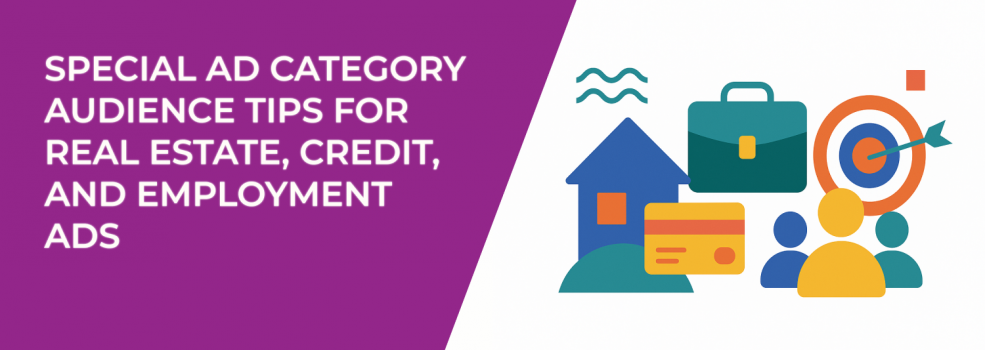Meta has strict rules when it comes to advertising real estate, credit, and employment offers. These fall under the Special Ad Category — a designation designed to prevent discrimination and keep campaigns fair. If you run ads in these industries, you can’t rely on the same targeting flexibility as other advertisers.
This guide breaks down the most important audience rules and offers practical tips so your ads stay compliant while still reaching the right people.
Why Special Ad Categories Exist
Housing, credit, and employment opportunities are sensitive areas. Misuse of targeting could lead to discrimination based on age, gender, or location. From January 21, 2025, all advertisers in the United States promoting financial products or services must use this category. Skip it, and your ads risk rejection.
European advertisers also face changes due to evolving privacy rules. This means restrictions may apply differently depending on where your campaign runs.
For more background on how targeting has changed in recent years, see Facebook Ads Targeting Updates: How To Adapt in 2025.
Audience Restrictions You Need to Know
Creating audiences under this category comes with a list of limits:
-
Age: Fixed to 18–65+. In Europe, credit ads may allow a different range, but only if industry rules demand it.
-
Gender: Must include all genders.
-
Location: You can target by city, county, or region, but never by ZIP code or postcode. Plus, Meta automatically expands targeting to a radius — 15 miles (25 km) in the US and 10 miles (17 km) in some other countries.
-
Exclusions: You can’t exclude locations, interests, or demographics.
-
Detailed Targeting: Many demographic and interest options are unavailable.
-
Lookalikes: Not available for Special Ad Category campaigns.
If you’re new to these limitations, it’s worth reviewing Facebook Ad Targeting 101: How to Reach the Right Audience.
Creating a Compliant Audience
So how do you build a strong audience under these limits? The process starts inside Meta Ads Manager:
-
Open your campaign or create a new one.
-
Go to the ad set and click on the Audience section.
-
Build a Custom Audience or create a Special Ad Audience (if eligible).
-
Choose your source, select your country or region, and set audience size.
Your saved audiences will be automatically updated to match these rules.
For step-by-step guidance, check How to Define a Target Audience for Marketing: a Step-by-Step Guide.
Tips for Better Targeting Under Restrictions
Even with limited options, you can still run effective campaigns:
1. Use Custom Audiences
Upload your own lists — past clients, leads, or email subscribers — to reach people who already know your brand. For example, a real estate agency could retarget people who filled out property inquiry forms.
LeadEnforce helps with this by letting you build audiences from Facebook group followers, which is especially useful for housing, credit, or employment ads.
2. Rely on Engagement
Target people who interact with your content. If someone watches half of your housing video or clicks on your lead form but doesn’t finish, retarget them. Engagement signals often mean higher intent.
3. Go Broad, Then Filter With Creatives
Since ZIP codes and lookalikes are off-limits, broad targeting is often the only choice. Use your ad copy as the filter. For example: “Looking for homes in Florida?” People outside your service area will usually ignore it, while the right ones will click.
4. Be Smart With Location
You can only target cities or regions with a 10–15 mile radius. Plan around this. If you’re advertising in Chicago, nearby suburbs will also be included. Make your copy location-specific to reduce wasted clicks.
5. Test Creatives Constantly
You can’t test audiences, so test ads instead. Run two versions with different headlines or visuals. Let performance decide the winner.
If you’re struggling with campaigns that underperform, see Facebook Ads Not Converting: How To Fix It.
Special Ad Audiences: What to Know
Meta used to allow the creation of Special Ad Audiences, which were similar to lookalikes but adjusted for restrictions. Since August 25, 2022, new ones can’t be created. If you already have them, they’ll still work, but only inside campaign setup.
Be aware: these audiences may be smaller due to iOS privacy changes, so they’re best used alongside other strategies.
Final Thoughts
Running ads for housing, employment, or credit isn’t simple. Restrictions are tight, but marketers who adapt — by using custom audiences, focusing on engagement, and testing creatives — can still reach qualified prospects.
The key is to understand the rules and turn them into strategy. With the right approach, campaigns can remain compliant, fair, and effective.
For more on campaign setup, check Meta Ad Campaign Objectives Explained: How to Choose the Right One.

